One of the greatest things—and most underappreciated—about bodybuilding-style training is how diverse you can be with your workouts. No workout need ever be the same! Day by day, you can change the grips you use, the machines or weights, and body positions as much as you’d like based on what feels right to you, and what allows you to concentrate on a working muscle. And when your body gets accustomed to one routine, there is always another one to challenge that lagging body part.
But back training can pose a few special problems. For one, the sheer volume of variations can be overwhelming—so much so that you might find yourself sticking to the same routine because the choice is so intimidating. And while a beautiful, muscular upper back is admired by lifters and non-lifters alike, it can be hard to decide exactly what “look” you are trying to achieve.
For bodybuilding men, the goal is usually to develop lats so thick and so broad, they’re like wings that connect directly to the hip. Many a male competitor—Dorian Yates, for example—has effectively “won” a show as soon as they faced the back of the stage. That’s how impressive a heavily muscled back can be.
For ladies, we have to give more thought to what we want to create.
Lower Lats or High Lats
The latissimus dorsi is the largest muscle of the upper body, and once developed, it can dictate the overall shape of your physique as much as any other part of the body.
While your training can help you shape your back to a certain degree, we’re all endowed with either high or low lats, in terms of the muscle insertions. “Low lats” connect low on the back and provide thickness and strength. “High lats” insert farther away from the hips, giving the illusion of upper back width and bringing focus to a tight torso which now appears narrower than it actually is.
If you’re a male bodybuilder onstage, you hope to be blessed with low lats. If you’re a woman competing on the same stage, you may hope for the exact opposite.
 ://www.bodybuilding.com/images/2019/july/back-workouts-for-women-1-b-700xh.jpg”/>
://www.bodybuilding.com/images/2019/july/back-workouts-for-women-1-b-700xh.jpg”/>
If genetics grant you a low-lat insertion and you train that muscle hard, you can create that “I’m a lifter” look that more women than ever are after. Just a warning, though: it might be the difference between buying comfortably off the rack and having to hunt for tops that fit right. Personally, I advise women never to let their workouts be completely ruled by their wardrobe, but it’s worth taking into consideration.
I competed for many years as a pro bodybuilder, and when I competed, there was just one stage category. As I retired, the fitness era had just started, and I had to rethink how I wanted to train my female clients. Fitness expanded into figure, physique, and bikini, and all these looks put a huge emphasis on wide shoulders that flowed down into a long, defined torso.
To create this look, we have to build the shoulders, chisel the waistline, and be thoughtful about how we develop the muscles of the back. If this is the look you want, there are three key points to remember:
- Your training emphasis should be on creating definition in the upper back.
- Tight, prominent spinal erectors will catch the eye and make your waist appear smaller.
- Overdeveloped upper traps will make your shoulders look narrower.
Upper traps and lower lats can change the overall shape of your body. It is a personal choice which also depends on whether you’re lifting for weight or lifting for a certain look.
The great thing is that your goal can change with the season, and with the sport you follow. I know many girls and guys who do powerlifting part of the year and physique training the rest.
Regardless of how you choose to structure your training or chase your goals, you need some dedicated back training in there! Here’s everything you need to know.
Know Your Back Muscles
 ://www.bodybuilding.com/images/2019/july/back-workouts-for-women-2-700xh.jpg”/>
://www.bodybuilding.com/images/2019/july/back-workouts-for-women-2-700xh.jpg”/>
- Trapezius: upper, mid, and lower. Their major function is to elevate, retract, and depress the scapula. The upper traps love to take over any upper-body movement, so to contain their development—and to have healthy shoulder mechanics—be very aware of your form.
- Latissimus dorsi. The lats contribute significantly to shoulder adduction, extension, and transverse extension, like when the elbow moves laterally away from the chest.
- Teres major. The teres major assists with most of what the lats do, and is also one of those very pretty “bubbly” muscles of the upper back.
- Teres minor and infraspinatus. These two small muscles are part of the rotator cuff, and both help extend, rotate, and abduct the shoulder. They’re crucial for shoulder health.
- Rhomboid: major and minor. These contribute to scapular retraction (squeeze your shoulder blades together—that’s scapular retraction), and scapular downward rotation.
- Posterior deltoid. You may hit these on shoulder day, but they also get worked by many row variations during back training. They’re major players in shoulder extension—when the arm goes behind the body—as well as shoulder abduction and external rotation
- Erector spinae. Although they’re largely located below other muscles, the spinal erectors are still important! They run the whole length of the back, straighten and rotate the spine, and when defined, they catch the eye and reinforce the appearance of a small waist.
That’s a lot of muscles, and a lot of movements. Luckily, training them all doesn’t have to feel like an anatomy lesson! I like to organize my back training simply, with what I call a “3×3” approach.
3×3: 3 Angles, 3 Grips
This is my “Hollywood Squares” approach to back training. It helps me make sure that each back workout is covering all the bases, but also provides easy ways to add variety into my training. If I notice that I haven’t done a certain grip or position in a while, I’ll get it back in the mix.
 ://www.bodybuilding.com/images/2019/july/back-workouts-for-women-3-700xh.jpg”/>
://www.bodybuilding.com/images/2019/july/back-workouts-for-women-3-700xh.jpg”/>
To start, we can break down back exercises into whether they are:
- Overhead. These include pull-downs, pull-ups (both body weight and on the assistance machine), straight-arm cable pull-downs, and dumbbell pull-overs.
- Horizontal. This is the full array of seated row exercises. For these, you could be sitting on a bench, on the floor, or in some cases, kneeling or half-kneeling. The weight moves horizontally into your chest.
- Bent-over. This angle is when you are standing bent over, or facing downward on an incline bench, with your shoulders higher than your hips. These rows can include dumbbells, barbells, cables, T-bars, and the godfather of them all, the deadlift.
Yes, there are angles in between these, but thinking this way will cover the majority of your back workout. Whatever “look” you want to create, you should use all three of the angles in every back workout. Then, at the end of back workouts, I’ll also mix two other angles in for detail/accessory work:
- Prone (face down). This is especially useful when concentrating on the rhomboids, and to a certain degree, the rear delts.
- Back extension. This is when you’re using a ball, 45-degree hyper, Roman chair, glute-ham developer, or some other angled or flat bench to isolate the lower back and erector spinae.
Once you have your angles dialed in, it’s time to consider the grips you’ll use. The grip you choose is paramount to the development you are going to create:
- Overhand. Lift your arms in front of you to chest height with your palms facing the floor. This is your “overhand” grip. It will put the emphasis more on the upper back and upper lats.
A fatal mistake I often see is someone using the straight bar on a seated cable row, but letting their elbows fall below their wrists. This pretty much eliminates the upper lats. Think of it this way: overhand wide grip = wide upper back.
- Neutral. With your hands raised in front of you, turn your palms to face each other. This is your neutral grip. Neutral grips will develop the mid back, the rhomboids, the teres, and the mid fibers of the trapezius. A neutral grip also allows you to move the load through a greater range of motion.
Prone neutral-grip lateral raises are a favorite of mine for mid-back development. Lie face down on a bench and hold a dumbbell in each hand with a neutral grip. Raise the dumbbells outward and squeeze the shoulder blades together.
- Reverse/underhand. With your arms raised in front of you, turn your hands to face upward. When you do this, you should feel your shoulder blades slide down. The upper traps love to get involved in any upper-body movement, but with this reverse grip, it is harder for them to do so.
 ://www.bodybuilding.com/images/2019/july/back-workouts-for-women-4-b-700xh.jpg”/>
://www.bodybuilding.com/images/2019/july/back-workouts-for-women-4-b-700xh.jpg”/>
You can use this reverse grip for overhead movements, for your horizontal rows, and your bent-over exercises. Any back exercise can be varied by using this hand position. If it’s uncomfortable for your wrists or elbows, you can also find many multi-grip bars and handles set at an angle partway between neutral and underhand. Definitely use them!
A reverse grip of any sort will activate and put an emphasis on the lower lats. If your lats tie in low, these are the movements that will create thickness and strength there. If your lats tie in high, you can continue to move some serious weight with a reverse grip, and yet still maintain a tight, narrow waist.
Now, let’s put all of these principles into action with a few workouts.
Back Workouts for Women
Back can be a challenging muscle group to those who are new to lifting. It’s not that the exercises are more complex, it’s because we literally can’t see the muscles working! When we’re training the “mirror muscles”—those we can see—it’s easier to make the connection between movement and form. It’s more obvious when, say, a biceps curl gets sloppy or when the knees buckle on a leg press. It’s not so simple to identify if your back work is not on point, and you may struggle to “feel” the back muscles working as a result.
For this reason, I suggest beginners start by mastering the basic exercises, using the 3 grips and the 3 angles. Spend some time alternating workouts like these 1-2 times a week. After a month or two, when the movements feel less awkward and you can feel your back working, move on and explore the diverse options available to you.
Beginner Back Workout 1
Beginner Back Workout 1 Note: Do not go to failure on lower back movements. The reps stated are just a guide. Once you feel fatigue or loss of control, stop the movement. Strength will come with time, but a tweaked back can put you out of action for weeks. Wide-Grip Lat Pulldown 4 sets, 15, 12, 10, 10 reps 
 Seated Cable Rows Close-grip. 4 sets, 12, 10, 8, 8 reps
Seated Cable Rows Close-grip. 4 sets, 12, 10, 8, 8 reps 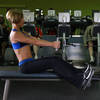
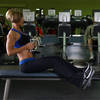 Reverse Grip Bent-Over Rows Using EZ-Bar. 4 sets, 12, 10, 10, 10 reps
Reverse Grip Bent-Over Rows Using EZ-Bar. 4 sets, 12, 10, 10, 10 reps 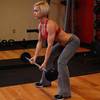
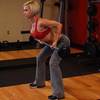 Hyperextensions (Back Extensions) 45-degree. 4 sets, 12 reps
Hyperextensions (Back Extensions) 45-degree. 4 sets, 12 reps 
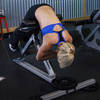
Beginner Back Workout 2
Beginner Back Workout 2 Hyperextensions (Back Extensions) Performed on Stability ball. 4 sets, 12 reps (no extra weight) 
 One-Arm Dumbbell Row 4 sets, 12, 10, 8, 10 reps
One-Arm Dumbbell Row 4 sets, 12, 10, 8, 10 reps 
 Underhand Cable Pulldowns 4 sets, 12, 10, 8, 10 reps
Underhand Cable Pulldowns 4 sets, 12, 10, 8, 10 reps 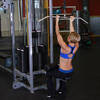
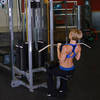 Seated Cable Rows Wide-grip. 4 sets, 12, 10, 10, 10 reps (Use a seated cable machine, pin loaded machine, or plate loaded seated back machine. You can even use resistance bands that are positioned at shoulder level. If you’re using a band, just up the reps and try to keep your elbows from dropping!)
Seated Cable Rows Wide-grip. 4 sets, 12, 10, 10, 10 reps (Use a seated cable machine, pin loaded machine, or plate loaded seated back machine. You can even use resistance bands that are positioned at shoulder level. If you’re using a band, just up the reps and try to keep your elbows from dropping!) 

Back Workout 3: Wide Shoulders, Narrow Waist
Wide shoulders, fully developed upper back and posterior delts, and a tight lower back with prominent erector muscles. This is a popular look both for competitors, and for women who just lift and wouldn’t mind showing it. But honestly, having a bodybuilding-style back-and-shoulder workout like this can also be a great accessory day for powerlifters, CrossFitters, and anyone else who focuses on strength and skill the rest of their lifting week.
This is a fairly high-volume workout, so consider it for intermediate lifters and above. And if it’s too much for you, dial it back by a set, or skip the dropsets.
Beginner Back Workout 3: Wide Shoulders, Narrow Waist Wide-Grip Lat Pulldown 4 sets, 12-15, 12-15, 6-8, 6-8 reps (plus a dropset on the final set, Wide-grip pull-ups with a band or on the assisted pull-up machine can also work here.) 
 Seated Cable Rows Neutral-wide grip. 4 sets, 10-12 reps (plus a dropset on the final set, If your gym doesn’t have a wide neutral-grip bar, use whatever neutral-grip handle they do have.)
Seated Cable Rows Neutral-wide grip. 4 sets, 10-12 reps (plus a dropset on the final set, If your gym doesn’t have a wide neutral-grip bar, use whatever neutral-grip handle they do have.) 
 Dumbbell Incline Row 4 sets, 12-15, 12-15, 10-12, 10-12 reps (use an underhand grip.)
Dumbbell Incline Row 4 sets, 12-15, 12-15, 10-12, 10-12 reps (use an underhand grip.) 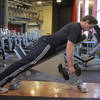
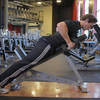 Dumbbell Rear Delt Row 4 sets, 10-12, 10-12, 8-10, 8-10 reps (with a dropset on the final set.)
Dumbbell Rear Delt Row 4 sets, 10-12, 10-12, 8-10, 8-10 reps (with a dropset on the final set.) 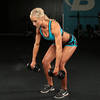
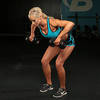 Dumbbell Lying Rear Lateral Raise 4 sets, 8-10 reps
Dumbbell Lying Rear Lateral Raise 4 sets, 8-10 reps 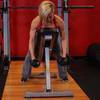
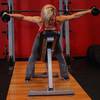 Hyperextensions (Back Extensions) Perform on Stability Ball. 4 sets, 12-15 reps
Hyperextensions (Back Extensions) Perform on Stability Ball. 4 sets, 12-15 reps 

Back Workout 4: Go Big or Go Home
This high-volume routine is for ladies who seek superior back strength and low, deep lats. For lifters following this type of workout, I would suggest doing posterior delts on a separate day, with shoulders. For the ladies who have one side stronger than the other, or who simply have trained bilaterally for the most part, I recommend mixing in some unilateral versions of movements, such as single-arm horizontal cable rows and single-arm bent-over cable rear delt raises.
When we’re training our mirror muscles, it can be easier to freestyle a workout. With back workouts, I find it’s better to have a plan in place before I enter the weight room.
By hitting all three angles, you can be assured that you worked all the muscles of your back, and by choosing the hand grips wisely you can be confident that you are building the design of your choosing.
Beginner Back Workout 4: Go Big or Go Home Close-Grip Front Lat Pulldown 4 sets, 8-12 reps (Hit failure on each set.) 
 Wide-Grip Pull-Up 4 sets, 10-12, 8-10, 8-10, 8-10 reps (Hit failure on each set. Use a band or assisted machine as needed.)
Wide-Grip Pull-Up 4 sets, 10-12, 8-10, 8-10, 8-10 reps (Hit failure on each set. Use a band or assisted machine as needed.) 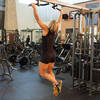
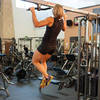 Reverse Grip Bent-Over Rows 4 sets, 12-15, 10-12, 6-8, 6-8 reps (Hit failure on each set. Use the same weight for all 4 sets.)
Reverse Grip Bent-Over Rows 4 sets, 12-15, 10-12, 6-8, 6-8 reps (Hit failure on each set. Use the same weight for all 4 sets.) 
 Rope Straight-Arm Pulldown 4 sets, 12-15, 12-15, 20-25, 20-25 reps
Rope Straight-Arm Pulldown 4 sets, 12-15, 12-15, 20-25, 20-25 reps 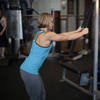
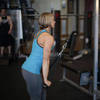 Dumbbell Scaption 4 sets, 10-12 reps (Perform these face-down on a flat or incline bench, with your thumbs pointing up.)
Dumbbell Scaption 4 sets, 10-12 reps (Perform these face-down on a flat or incline bench, with your thumbs pointing up.) 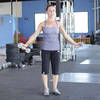
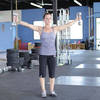 Hyperextensions (Back Extensions) 4 sets, 12-15 reps
Hyperextensions (Back Extensions) 4 sets, 12-15 reps 

For a comprehensive training plan that will help you build shapely muscle all over, check out Jamie Eason’s LiveFit Trainer, only on Gym2k.com All Access.
Gym2k.com Articles






Leave a Reply
You must be logged in to post a comment.